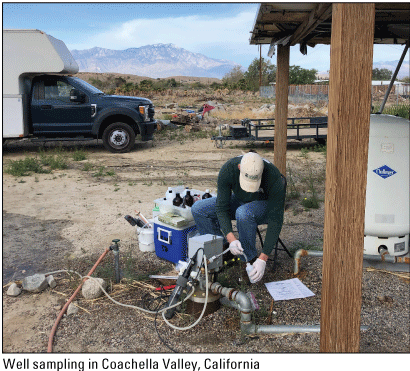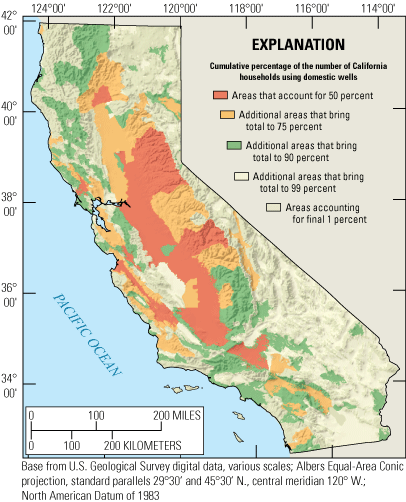California Groundwater Ambient Monitoring and Assessment (GAMA) Program Priority Basin Project: Domestic-Supply Assessment
Links
- Documents:
- Superseded Publications:
- Download citation as: RIS | Dublin Core
What is the GAMA Priority Basin Project (GAMA-PBP)?
The GAMA-PBP is a comprehensive assessment of statewide groundwater quality in California. The first phase of the GAMA-PBP in 2004–15 assessed groundwater resources used for public drinking-water supplies. The second phase is assessing groundwater resources used for domestic drinking-water supplies. An estimated 2 million Californians rely on individual domestic wells or State small-system wells for drinking water, and far less information is available about these resources than about public-supply resources. The U.S. Geological Survey (USGS) began sampling wells for this second phase in 2012. Domestic wells typically are drilled to shallower depths in the groundwater system than public-supply wells. Shallow groundwater may respond more quickly and be more susceptible to contamination from human activities at the land surface than groundwater in deeper aquifers.
The California State Water Resources Control Board’s (SWRCB) GAMA-PBP was developed in response to the Groundwater Quality Monitoring Act of 2001 (Water Code sections 10780–10782.3): a public mandate to assess and monitor the quality of groundwater resources used for drinking-water supplies, and to increase the availability of information about groundwater quality to the public. The USGS is leading the GAMA-PBP, in cooperation with the SWRCB.
Well-owner participation in the GAMA-PBP is voluntary. Stewardship of California’s groundwater resources is a responsibility shared between well owners, communities, and the State. Participants and collaborators in the GAMA-PBP include Regional Water Quality Control Boards, Department of Water Resources, SWRCB Division of Drinking Water, local and regional groundwater management entities, county and local water agencies, community groups, and private citizens.

How Will Data Collected by the GAMA-PBP Be Used?
The project will provide many benefits to State, local, and community participants, as well as individual well owners. Project results will
-
• Provide well owners with water-quality and water-level data for their well and assist with locating well depth information,
-
• Establish baseline groundwater quality for comparison with future conditions,
-
• Identify areas of California where domestic households rely upon poor-quality groundwater for drinking-water supplies,
-
• Improve understanding of local, regional, and statewide hydrogeology,
-
• Produce groundwater-quality reports for each study area,
-
• Provide new information for local, regional, and statewide groundwater stakeholders,
-
• Provide new data for the SWRCB’s GAMA Groundwater Information System (GAMA GIS) publicly accessible online database, and
-
• Compare water quality in the shallow and deeper aquifer systems.
GAMA Priority Basin Project Domestic-Supply Assessment Study Design
The locations of domestic wells across California were identified from well-drillers’ logs. Areas of the State with the greatest numbers of households that rely on domestic wells were prioritized for sampling for this project (see map). These areas will be grouped into 20 to 25 study units. A chicken-wire-like grid is overlain on the study unit, and one well is sampled per grid cell. About 30–100 domestic wells will be sampled in each study unit to provide an assessment of the groundwater quality. Wells are identified by door-to-door canvassing, and participation is voluntary. Groundwater level in the well will be measured and water samples will be collected for analysis of many water-quality parameters, including nutrients, human-made organic constituents, naturally occurring trace elements, and tracers used to help identify the source of recharge and relative age of groundwater (table 1).

Table 1.
Samples collected at each domestic well by the GAMA-PBP.Reporting Results
The USGS will provide results to individual well owners. Well owner information will be kept confidential in published data and reports released to the public. Data summary and interpretive reports and web tools for exploring and downloading the data are available on the SWRCB and USGS websites (https://www.waterboards.ca.gov/water_issues/programs/gama/ and https://ca.water.usgs.gov/gama).
GAMA-PBP reports and data can be obtained from:
GAMA-PBP Project Chief
U.S. Geological Survey
California Water Science Center
6000 J Street, Placer Hall
Sacramento, California 95819-6129
Telephone: (916) 278-3000
https://ca.water.usgs.gov/gama
GAMA Program Unit
State Water Resources Control Board
Division of Water Quality
1001 I Street, 15th Floor
Sacramento, California 95814
Telephone: (916) 341-5577
For more information concerning the research in this report, contact the
Director, California Water Science Center
U.S. Geological Survey
6000 J Street, Placer Hall
Sacramento, California 95819
https://www.usgs.gov/centers/california-water-science-center
Publishing support provided by the U.S. Geological Survey
Science Publishing Network, Sacramento Publishing Service Center
Disclaimers
Any use of trade, firm, or product names is for descriptive purposes only and does not imply endorsement by the U.S. Government.
Although this information product, for the most part, is in the public domain, it also may contain copyrighted materials as noted in the text. Permission to reproduce copyrighted items must be secured from the copyright owner.
Suggested Citation
Shelton, J.L., and Tejeda, E., 2024, California Groundwater Ambient Monitoring and Assessment (GAMA) Program Priority Basin Project—Domestic-Supply Assessment: U.S. Geological Survey Fact Sheet 2024–3002, 2 p., https://doi.org/10.3133/fs20243002.
ISSN: 2327-6932 (online)
Study Area
| Publication type | Report |
|---|---|
| Publication Subtype | USGS Numbered Series |
| Title | California Groundwater Ambient Monitoring and Assessment (GAMA) Program Priority Basin Project: Domestic-Supply Assessment |
| Series title | Fact Sheet |
| Series number | 2024-3002 |
| DOI | 10.3133/fs20243002 |
| Publication Date | March 14, 2024 |
| Year Published | 2024 |
| Language | English and Spanish |
| Publisher | U.S. Geological Survey |
| Publisher location | Reston, VA |
| Contributing office(s) | California Water Science Center |
| Description | 2 p. |
| Country | United States |
| State | California |
| Online Only (Y/N) | Y |


